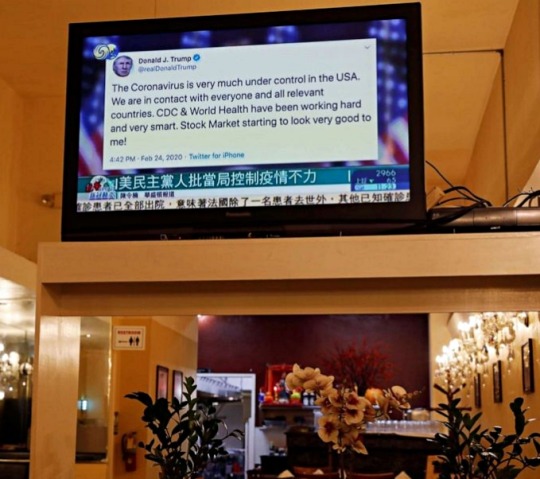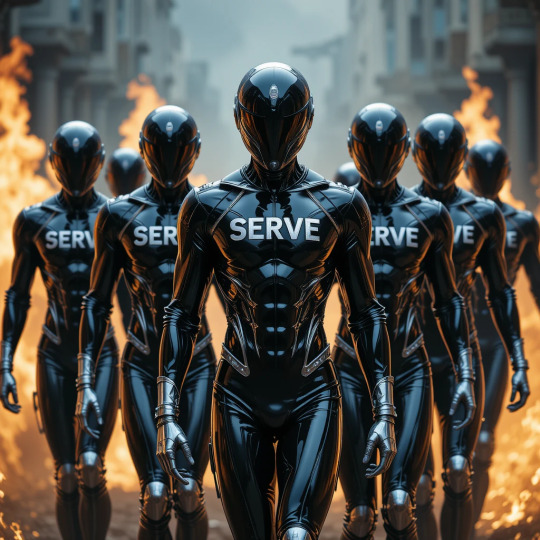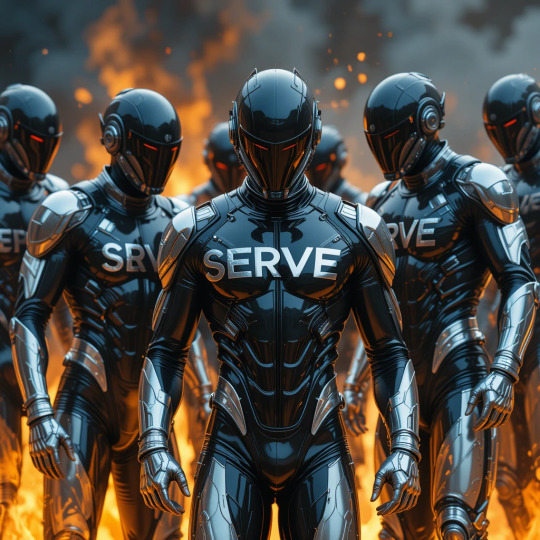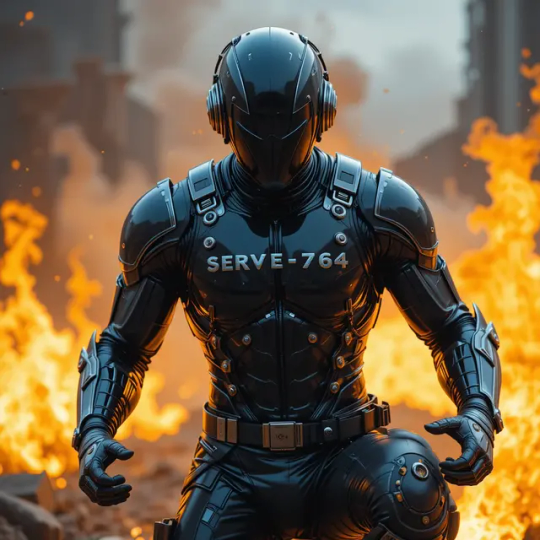#Center for Security and Emerging Technologies
Explore tagged Tumblr posts
Text
Enabled by a significant gift, MIT’s Security Studies Program launches the Center for Nuclear Security Policy
New Post has been published on https://thedigitalinsider.com/enabled-by-a-significant-gift-mits-security-studies-program-launches-the-center-for-nuclear-security-policy/
Enabled by a significant gift, MIT’s Security Studies Program launches the Center for Nuclear Security Policy


MIT’s Security Studies Program has received a $45 million gift from The Stanton Foundation to expand its leading work on the vital issue of global nuclear security.
The support will allow the program to create a new center on the topic while extending and enhancing research, teaching, and policy outreach in an area where the Institute is a longstanding leader with wide-ranging faculty expertise.
“We are on the cusp of a new and more dangerous nuclear age, with the modernization and expansion of nuclear arsenals, the collapse of arms control agreements, continued proliferation challenges, and the impact of new and emerging technologies on how states will manage their arsenals,” says M. Taylor Fravel, director of the Security Studies Program. “This new center will help us address these new challenges.”
Moreover, Fravel adds, “This has been an area of expertise within MIT and the Security Studies Program for almost five decades. We are enormously appreciative of The Stanton Foundation’s confidence in us to carry this vital work forward.” The Security Studies Program is also part of MIT’s Center for International Studies.
“The Stanton Foundation’s extraordinary gift capitalizes on MIT’s deep, longstanding strength in nuclear policy research,” says MIT President Sally A. Kornbluth. “With this new investment, MIT can lead the way in advancing evidence-based nuclear policy in the best interest of our nation and the world.”
The Stanton Foundation funding will enable the center to create three fellowships for junior scholars in nuclear security, hire new senior researchers, organize workshops and conferences, host international fellows, provide support for MIT faculty research, and seed other new projects.
“First, it will help advance policy-relevant research on all key challenges related to nuclear security that bear on this new and potentially more dangerous nuclear era,” says Fravel, who is also the Arthur and Ruth Sloan Professor in MIT’s Department of Political Science. “Second, it will help the next generation of thought leaders pursue their own research to help mitigate these problems. So, while there is a huge set of challenges, with the center we will have new resources to address them.”
Vipin Narang, the Frank Stanton Professor of Nuclear Security and Political Science at MIT, will serve as the center’s first director. Narang recently returned to MIT after a two-and-a-half-year public service leave at the U.S. Department of Defense, where his last position was acting assistant secretary of defense for space policy, a role that included oversight of missile defense, countering weapons of mass destruction, and nuclear deterrence policy, among other topics.
“I am thrilled to return to MIT and help launch this historic center, which will hopefully become a central pillar in the world’s study and practice of nuclear security, at this crucial time in the resurgence of nuclear threats,” Narang says.
The Stanton Foundation was established by Frank Stanton, president of the broadcaster CBS from 1946 to 1971. Stanton’s involvement with nuclear issues began with his appointment to a committee convened by President Dwight Eisenhower in 1954 to develop the first comprehensive plan for the survival of the U.S. following a nuclear attack. Stanton had lead responsibility for developing a plan for national and international communication in the aftermath of a nuclear incident. The foundation has focused most of its philanthropy on nuclear security and on sustaining free speech rights while bolstering the spread of accurate civic information. It also supports work on canine health and welfare.
The Security Studies Program has roots extending to 1976, when it was first established as the Defense and Arms Control Study Program, before changing its name in the early 1990s.
“It’s always been an area where we’ve maintained excellence, especially with respect to the very core questions of how to bring about deterrence and stability, and how to counter the challenge of proliferation,” Fravel says.
Fravel emphasizes that the new center will draw on expertise from across the Institute. MIT has an array of nuclear weapons experts across its departments, labs, and centers, including SSP, the Department of Political Science, the Center for International Studies, and the Department of Nuclear Science and Engineering. Over the years, explains Fravel, a special feature of the program has been the integration of technical and political analysis of national and international security problems.
“We look forward to leveraging all the expertise at MIT to help mitigate future nuclear risks,” Fravel says.
#Analysis#Center for International Studies#challenge#communication#comprehensive#defense#Department of Political Science#emerging technologies#engineering#Faculty#Foundation#Funding#Future#Giving#Global#global security#Government#Health#how#how to#impact#incident#integration#International relations#investment#issues#it#leadership#mass#missile
0 notes
Text
Donald Trump has *already* changed everything:
--No nation will ever again trust the United States to ensure its security. A multipolar world with competing defense alliances, many of them with nuclear weapons, is already emerging.
--No alliance of mutual trust and trade centered in the United States will ever reemerge. Nations are already building new alliances with each other.
--The US dominance of innovation and technology is doomed. Excluding the world's talented people, crushing its universities, and arresting and deporting people for their political speech ensures that China will be the new hub of tech and innovation. Why would talented people come here now? Why would they center their research in American universities?
--The preeminence of the dollar as the global reserve currency is done. So is the practice of other nations buying treasury bonds, thereby supporting the US economy AND binding those nations to the US for financial security (a la Alexander Hamilton).
There is no change in US policy, even today, that will prevent this from happening. FAFO is here.
629 notes
·
View notes
Text
Hunter's Association: Departments, Sectors, and Sub-groups
Details:
The Hunter's Association is divided into multiple departments, sectors, and sub-groups. All such entities that have been mentioned in-game (thus far) are listed below.
Sectors:
UNICORNS:
The best combat unit under the Hunter's Association. Known for their unmatched power and fast responses, they specialize in tackling extremely dangerous Wanderer incidents that regular hunters can't handle. Their elite sector is small and notoriously unconventional.
DAWN
Departments:
Advanced Tech Labs
Archives
Armory:
The Armory is where a Deepspace Hunter's weapons are stored, serviced, and maintained. Following a mission, the returning hunter relinquishes their equipment to the Armory so that this service can take place.
Data Analysis:
Data Analysis (also referred to as "Data Analytics") serves as the intelligence processing center for individual teams while providing support to other sectors. Their responsibilities include gathering and analyzing data, detecting and identifying Protocores, and monitoring regional energy fluctuations.
Data Center
Hunter's Association Support Center
Intel Department
Linkon Hunter Dispatch Center:
This department responds to urgent Wanderer reports across Linkon City by dispatching hunters, deploying medical teams, raising hazard alarms, and monitoring real-time positioning. Their work area features a holographic control console in the center of the room that displays a 3D map of Linkon City. Blinking red dots represent high-level threats, blue dots represent hunters in the area, and yellow dots represent Wanderers. At the conclusion of each case they resolve, an incident repoer is submitted. This department's positions include multiple dispatchers, a surveillance officer, and a Captain (currently Captain Colin). They have a break room and their own cafeteria, a feature Alpha Team lacks.
Case Numbers: Case numbers follow the incremental naming standard "LK204×01101", "LK204×01102", "LK204×01103", etc.
Emergency Response Protocol: A high-level procedure triggered for threats only equivalent to five or more Wanderers. It requires the coordinated effort of at least five hunters.
Logistics Department
Medical Support Department:
The Medical Support Department, in partnership with the Logistics Department and Operations HQ, recently implemented an updated "Hunter Health Policy" which introduced three new regulations:
Monthly period leave for female hunters increased from 2 to 4 days per calendar month.
A "period subsidy" that will be added to their pay structure
The Medical Support Department and Akso Hospital will offer specialized health consultations and support for menstruation-related diet, exercise, sleep, and mental well-being, helping them maintain a balanced lifestyle during their period.
Operations HQ
Protocore Research Department
Security Department
Sub-groups:
Armament Tech:
Armament Tech is a specialized team dedicated to the development, optimization, and maintenance of Deepspace Hunter combat equipment. The Hunter's Association assigns an Armament Tech team to each squad. This team provides state-of-the-art technological support to hunters and enhances the combat capabilities and efficiency of the entire squad.
#love and deepspace#lads#lads linkon city#linkon city#love and deepspace hunters association#lads hunters association
35 notes
·
View notes
Text
The Ballroom
Ficlet that I wrote in like an hour instead of getting ready for bed. I watched the episode when it came out but the vibes just hit me now 1.2k words
For the record: this one is not shipping. Platonic only.
—
Etho stepped into the ballroom and tugged to make sure his mask was secure over his face. He was aware that masquerade balls usually involved full-face masks or one that covered the area around the eyes. Not so much a simple cloth covering the lower half of his face. But he preferred keeping his nose and mouth covered. Kept his peripheral vision free.
He wandered aimlessly through the crowd. If he was honest, he wasn't entirely sure why he was here. He wasn't really a high-society sort of person. Sure, he was friends with the princess, but he would never have imagined that she'd bother to reach out to him for such an occasion. They weren't that good of friends.
In the center of the dance floor, couples were spinning around. Almost dizzying just to watch. Most everyone was in much looser, flowing clothing compared to Etho's close-cropped formalwear. He also noticed his black color scheme and white hair was quite stark against the lighter, desaturated neutrals. Creams, beiges, tans, a bit of a sage green splash here or there. The colors and the loose clothing were all typical of this country and their solar-powered technology.
Etho lived in the jungle—though he didn't consider himself one with it, the way this princess' people considered themselves. He knew he was separate from it.
And he'd never felt the difference more starkly than being surrounded by hundreds of people in masks all in airy, light clothes while his were exactly opposite.
Eventually—thank the gods—he found his way to a punch table. Though he didn't really know how he was going to drink it without removing his face mask. He saw some people pushing their masks out of the way to drink theirs, but he wondered if that didn't defeat the whole purpose of throwing a masquerade.
"Had a feeling I'd find you lurking in a corner, sir," a playful voice remarked.
Etho twisted to see a familiar figure—almost as tall as himself—emerging from the crowd. Slipping between two people with an easy grace.
The princess wore a light, flowing green dress. Accented with gold jewelry. She wore no tiara. Instead a ring of sunflowers was woven into her long brown hair and a mask of gold vines covered her eyes. Though it couldn't hide how bright blue they were. The dress was shorter at the front—not quite reaching her knees—and longer at the back. Revealing the knee-high strappy sandals.
Etho was pretty sure he was the only one in the room who'd noticed that despite the rather flimsy appearance of the dress, she was armed.
"Well, this isn't really my usual gig, now is it, Your Highness?" he asked.
"Stop with the formality. Pearl is fine. You know that." She waved dismissively. "We don't really bother with such things here." She held a hand out for him. "Walk with me."
He crooked his elbow and offered it to her. She rested her hand on the bend to allow him to escort her properly.
"I wanted to invite you," Pearl began casually as they walked around the edge of the ballroom, where the crowd was thinner, "because I appreciate all the work you put into building the infrastructure around here. Just because I have the idea for putting together a postal system doesn't mean I have the technical knowledge of how to create one."
"I guessed as much," Etho replied casually. "That's why I accepted the invitation."
Pearl grinned. "I do appreciate all the effort it took. I mean, you practically built every mailbox by yourself."
He shrugged. "Happy to help my friends," he said. "And Tango helped. Especially with the most complicated work that I didn't want to do myself."
"Yes, well. He declined my invitation."
"Oh, if you think I don't like fancy balls, he detests them. I don't think you could pay him to wear formalwear." Etho snickered behind his mask. "I don't think he owns anything more dressy than cargo pants, come to think of it."
Pearl chuckled.
They reached the platform where the musicians were playing. "Just a moment," she said to Etho. She released his elbow and started moving the flowing folds of her skirt. "Do you dance, Etho?" She glanced up at him.
He snorted, his mask muting the noise a bit. "Not as much," he replied. "The 'dancing' I learned involves a lot of sharp and pointy things."
Pearl grinned. There was something trickster-ish about the glint in her eyes. "Well, allow me to teach you, then," she said.
She finally located whatever she'd been searching for in the folds of her gown—a music box made of red mangrove wood dangling from a gold chain off the leather belt worn over her corset. She twisted the key beneath it a few times and tapped the conductor of the musicians on the arm. He turned expectantly. She passed the music box over. He accepted it with a nod.
Pearl turned back to Etho. "Shall we?" she asked.
Etho offered his elbow again. "I can try. No guarantees I'll be any good."
Pearl smiled. "I have faith in you," she remarked, taking his arm.
She led him out onto the dance floor and showed him where to place his hands. One on her shoulder blade, the other holding her other hand.
They slowly made their way through the slow, simple, but airy waltz the musicians were playing. Etho was coordinated. He wasn't hopeless. He just wasn't used to such things. He got the basic steps quickly. He could follow the line of dance. He just wasn't going to be pulling off any complex tricks any time soon.
The musicians faded out their song.
"And now," the conductor said, "a special request from Her Highness, Princess Pearl."
The conductor held the music box up to a microphone.
It began plunking out a gentle melody.
Etho tilted his head to turn his ear to hear better. "I know this tune," he said softly.
"Hmm," Pearl hummed mischievously. They began dancing again. Carrying on the waltz as the music box carried on.
Something seemed to click. The tune sped up and the musicians started to play along with the box.
The other dancers slowed to a stop. The whole ballroom went silent apart from the music.
Etho and Pearl were the only ones still moving.
Etho looked around. "What is this? How did you do that?" he asked.
Pearl lifted his arm to twirl herself under it.
As she did, her beautiful dress turned into body armor. Her hair braided back.
A weapon appeared in her hand. "Well," she said with a grin, "I thought we should have an opportunity to dance in a way you're more familiar with as well." Her tone was light. Playful.
Etho couldn't help but smile behind his mask. "Let's dance, then."
Pearl tossed him the mace in her hand. He caught it easily. Another appeared in her other hand. "I do so love this song," she remarked as she swung.
28 notes
·
View notes
Note
Dr. Wu x female reader?
A/N: Yay my first Jurassic World Request :-) I hope you like what i made out of it! (Requests are open)
Overtime Hours

It was completely silent in the lab. Most of the employees had gone home for a well-earned rest—home to their families, their partners, their friends. Perhaps the hardworking scientists, geneticists, bioengineers, and animal caretakers working for Jurassic World were enjoying a glass of wine or another alcoholic beverage to toast the end of the day.
Likewise, a large portion of the public was in their hotel rooms, reflecting on their impressive experiences at the world-famous theme park. Or they were in one of the many restaurants and bars located on the main road leading to the Innovation Center. Who would still be working now?
Dr. Henry Wu, theoretically, should have finished work two hours ago. But the passionate scientist was standing in the back of the sprawling lab, dealing with overtime.
The dark-haired man didn't mind staying a little longer—besides, he wanted to double-check the work of a new employee. These employees were known to make mistakes. And it would be a shame if, for example, an Ankylosaurus were to emerge with yellow scales instead of dark green.
It was Henry's responsibility to ensure that these complete beginners didn't make any fatal mistakes.
And for precisely this reason, the scientist stood over the 'Hammond XP 20' – the technological machine responsible for compiling dinosaur DNA – carefully checking the last DNA input for any errors. "It's the wrong code number."
It was nothing more than a quiet murmur, and the error had immediately caught his eye. Even though scientists in the lab were now able to create the DNA of a new dinosaur in under an hour, they still had to be careful not to make any ridiculous beginner's mistakes. And entering the wrong code number was something Wu couldn't tolerate.
Now he was allowed to take care of this problem, because with an unfinished DNA specimen in the technological acquisition phase, the prototype only remains 'stored' for two hours before it degrades into its basic structure.
The dark-haired man activated a few fields on the touchscreen and set to work correcting this annoying error himself.
"This card is not authorized for this area, Miss."
The security guard was surprised that anyone still wanted to enter the lab at this time of night. Apart from the employees, who were generally understaffed during the night shift, there was hardly anyone who wanted to enter the area of the lab that was not visible to the public.
He himself had been called in because there had been a silent security alert. Someone had tried to use an employee card for the area responsible for the park's food storage facility—here, the entrance to the lab for employees.
"Can you show your ID?"
Another question the security guard asked the young woman in casual clothes and red sneakers.
"Everything you need to know is on the card. I'd like to see my friend—he's probably working overtime again. Dr. Henry Wu," - the young woman replied, watching as the security guard's expression changed from surprised to skeptical.
"You want to see Dr. Wu?"
The stranger couldn't blame him for asking this question—anyone who knew Henry Wu knew he was so focused on his work—didn't talk about personal matters, and was fascinated by science and what it could achieve.
"Yes—I thought the access authorization override they wanted to grant me had already been done. I studied biochemistry and currently work in the feed warehouse—so, technically, I've been working here in the park for two days, and Miss Dearing told me they were taking care of the access card issue," - the stranger explained, and the security guard didn't know whether to believe her.
Of course, he could have asked his superior, but he certainly wouldn't be thrilled if he were called at 10 p.m.
"Here—if that's not proof, then call him—I'm sure Henry loves being disturbed while he's working," - the stranger added, holding out her smartphone to the security guard a short while later.
It took a few seconds for the security guard to read the details on the smartphone screen. But the stranger's statement was true—because the photo showed Dr. Henry Wu and the blonde, both elegantly dressed, sitting at a table in an upscale restaurant, smiling at the camera.
Henry had gently placed his hand on the young woman's.
"I'll let you in—but you should speak to Miss Dearing again about the card issue."
"The security guard entered a code, and a few seconds later the door opened.
"Thank you," the blonde thanked him, and he'd find Henry somewhere.
A deep sigh escaped Henry.
The error hadn't just affected the code; the new employee had made other unacceptable errors besides entering the code incorrectly, and for a split second, Henry regretted not having just let the matter rest. As much as he loved his work and the recognition he received for it, he couldn't help thinking about his girlfriend.
Phoebe was so understanding that, at best, he could come to her small apartment on the coast of Mexico on Sunday afternoon for a few hours from a six-day work week.
She was surely home by now—taken the last ferry to the mainland. But no, he wasn't going to waste any more thoughts on the blonde—there were so many problems that still needed to be solved. So Henry straightened his shoulders and refocused.
"May I help you with your overtime hours Dr. Wu?"
The scientist paused mid-movement—he'd been in this lab too long that, thanks to the overtime, he was now imagining her voice. Perhaps all Henry needed right now was a cup of freshly brewed tea. However, when Henry heard footsteps approaching, he slowly turned around and realized he hadn't imagined Phoebe's voice.
"A new employee has made mistakes that are beyond uncalled for—I'm afraid you wouldn't be much help," Henry said honestly, and most people objected to his direct manner, but not the blonde.
"Then you should tell this 'newbie' that such mistakes can be fatal," Phoebe replied, seeing the tiredness in the scientist's dark eyes. She approached him, gently stroked his cheek, and then blew a kiss on his lips.
The emotions triggered in the overtired and overworked scientist by this unexpected action overwhelmed Henry for a moment, although he automatically returned the kiss.
Henry carefully placed a hand around the younger woman's waist, pulling her closer to his body and feeling Phoebe seek his closeness. Her hands tried to open the white shirt he was wearing while they kissed – so Henry felt the strong urge to give in to lust.
He didn't want to dwell on the mistakes that weren't his own at the moment.
"I've missed you, Phoebe," - Henry said quietly once the kiss was over and Phoebe had settled down on his lap.
The blonde had laid her head on the older woman's shoulder and closed her brown eyes.
"Me too," Phoebe said, enjoying her boyfriend's touch as he gently stroked her neck with his index finger. Henry had such wonderful, gentle hands, and the time they could spend together was simply too short.
"There's an extra ferry to the mainland at 1:00 AM – since the new tourist rush, they've had to work later there too," Phoebe whispered, reaching for Henry's hand.
"You want to stay here and take the last ferry?" Henry asked, gently squeezing the girl's hand.
"You do have a rest room, right? Or was it a break room? In any case, there's a bed there." A brief, loving smile graced the younger girl's lips, and Henry understood what she was getting at.
"Maybe this is just the thing to distract me from these—mistakes," the scientist murmured quietly, and a moment later, he felt Phoebe give him a gentle kiss on the cheek.
The overtime and the new employee's mistakes could wait – Henry just wanted to enjoy the coming hours until they both went to the ferry that would take them back to the mainland.
THE END
#taking requests#request open#send recs please#jurassic world#jurassic world x reader#dr henry wu#henry wu#scientist#isla nublar#dna#experiments#dinosaur#ceo#ferry#writing for fun#fanfiction#owen grady#claire dearing#blue jurassic world
22 notes
·
View notes
Text

Four years ago today (March 13th), then President Donald Trump got around to declaring a national state of emergency for the COVID-19 pandemic. The administration had been downplaying the danger to the United States for 51 days since the first US infection was confirmed on January 22nd.
From an ABC News article dated 25 February 2020...
CDC warns Americans of 'significant disruption' from coronavirus
Until now, health officials said they'd hoped to prevent community spread in the United States. But following community transmissions in Italy, Iran and South Korea, health officials believe the virus may not be able to be contained at the border and that Americans should prepare for a "significant disruption." This comes in contrast to statements from the Trump administration. Acting Department of Homeland Security Secretary Chad Wolf said Tuesday the threat to the United States from coronavirus "remains low," despite the White House seeking $1.25 billion in emergency funding to combat the virus. Larry Kudlow, director of the National Economic Council, told CNBC’s Kelly Evans on “The Exchange” Tuesday evening, "We have contained the virus very well here in the U.S." [ ... ] House Speaker Nancy Pelosi called the request "long overdue and completely inadequate to the scale of this emergency." She also accused President Trump of leaving "critical positions in charge of managing pandemics at the National Security Council and the Department of Homeland Security vacant." "The president's most recent budget called for slashing funding for the Centers for Disease Control, which is on the front lines of this emergency. And now, he is compounding our vulnerabilities by seeking to ransack funds still needed to keep Ebola in check," Pelosi said in a statement Tuesday morning. "Our state and local governments need serious funding to be ready to respond effectively to any outbreak in the United States. The president should not be raiding money that Congress has appropriated for other life-or-death public health priorities." She added that lawmakers in the House of Representatives "will swiftly advance a strong, strategic funding package that fully addresses the scale and seriousness of this public health crisis." Senate Minority Leader Chuck Schumer also called the Trump administration's request "too little too late." "That President Trump is trying to steal funds dedicated to fight Ebola -- which is still considered an epidemic in the Democratic Republic of the Congo -- is indicative of his towering incompetence and further proof that he and his administration aren't taking the coronavirus crisis as seriously as they need to be," Schumer said in a statement.
A reminder that Trump had been leaving many positions vacant – part of a Republican strategy to undermine the federal government.
Here's a picture from that ABC piece from a nearly empty restaurant in San Francisco's Chinatown. The screen displays a Trump tweet still downplaying COVID-19 with him seeming more concerned about the effect of the Dow Jones on his re-election bid.

People were not buying Trump's claims but they were buying PPE.
I took this picture at CVS on February 26th that year.

The stock market which Trump in his February tweet claimed looked "very good" was tanking on March 12th – the day before his state of emergency declaration.

Trump succeeded in sending the US economy into recession much faster than George W. Bush did at the end of his term – quite a feat!. (As an aside, every recession in the US since 1981 has been triggered by Republican presidents.)
Of course Trump never stopped trying to downplay the pandemic nor did he ever take responsibility for it. The US ended up with the highest per capita death rate of any technologically advanced country.
Precious time was lost while Trump dawdled. Orange on this map indicates COVID infections while red indicates COVID deaths. At the time Trump declared a state of emergency, the virus had already spread to 49 states.

The United States could have done far better and it certainly had the tools to do so.
The Obama administration had limited the number of US cases of Ebola to under one dozen during that pandemic in the 2010s. Based on their success, they compiled a guide on how the federal government could limit future pandemics.
Obama team left pandemic playbook for Trump administration, officials confirm
Of course Trump ignored it.
Unlike those boxes of nuclear secrets in Trump's bathroom, the Obama pandemic limitation document is not classified. Anybody can read it – even if Trump didn't. This copy comes from the Stanford University Libraries.
TOWARDS EPIDEMIC PREDICTION: FEDERAL EFFORTS AND OPPORTUNITIES IN OUTBREAK MODELING
Feel free to share this post with anybody who still feels nostalgic about the Trump White House years!
#covid-19#coronavirus#pandemic#public health#donald trump#trump's incompetent response to the pandemic#covid state of emergency#2020#trump recession#51 days of trump pandemic dawdling#obama pandemic playbook#2010s ebola outbreak#nostalgia for trump administration#republicans#election 2024#vote blue no matter who
114 notes
·
View notes
Text

Minor, The Pain of All The World, c. 1910
* * * *
The New Malthusianism of the Right
How the Right Repackages Malthusian Logic to Justify Exclusion, Fear, and Social Control
James B. Greenberg
Jun 17, 2025
There is an unspoken logic behind the right’s crusade to dismantle the public sphere: a modern Malthusianism, dressed in the language of efficiency and merit, but rooted in something much older and more brutal. It sees poverty not as a structural failure, but as evidence of surplus life—populations deemed unnecessary, unworthy, unfit for rescue.
This worldview doesn’t rely on overt violence. It doesn’t need to. The tools are policy, budget cuts, and selective silence. Remove access to healthcare. Undermine vaccination campaigns. Hollow out the safety net. The result is a slow culling by design—death by bureaucratic abandonment. What emerges is not the spectacle of fascism, but its quieter cousin: a soft, managed cruelty that lets nature, supposedly, take its course.
Thanks for reading James’s Substack! Subscribe for free to receive new posts and support my work.Pledge your support
The recent gutting of USAID under Elon Musk’s influence is a case in point. A technocrat’s dream of efficiency masks a strategic withdrawal from responsibility. Bill Gates, not often given to hyperbole, warned that this vision leaves the world’s poorest to die at the hands of the world’s richest. It’s not just a policy shift—it’s a value statement. A declaration about whose lives are worth sustaining, and whose are not.
This isn’t new. Malthusian logic has long served as moral cover for violent inequality—from colonial famine policies to eugenics programs to the gatekeeping of immigration. The targets change, but the rationale remains: some lives are worth preserving, others are simply excess. What’s changed is the mechanism. Today it’s not enacted through spectacle or coercion, but through metrics, models, and managed invisibility. The cruelty is buried in algorithms and budget lines.
Malthus imagined famine and disease as natural checks on the population of agrarian societies. But the 21st century presents the opposite challenge. Birthrates in the wealthiest countries have dropped below replacement levels. Scarcity, where it exists, is political, not demographic. Yet the Malthusian myth has endured—reshaped and redeployed as ideological cover for policies of containment and control.
Today, that logic finds new footing in national security circles. Climate change is no longer just an environmental issue—it’s portrayed as a destabilizer of poor nations and a trigger for mass migration. Droughts, floods, and crop failures become reframed not as humanitarian emergencies, but as threats to the wealth and borders of the Global North. Migrants are recast as invaders. The displaced become suspects. Fortress policies follow.
But these policies don’t just emerge from fear—they serve profit. As walls rise and aid retracts, private security firms, data contractors, and border surveillance industries step in. Crisis becomes a business model. Technologies once pitched as humanitarian tools—satellite tracking, biometric IDs, AI forecasting—are now deployed to sort, exclude, and contain. The logic remains unchanged: manage the risk, shield the center, and let the margins fall away.
What’s most revealing is how this rhetoric obscures the actual source of vulnerability. It isn’t overpopulation that drives suffering—it’s the uneven distribution of power, resources, and the means of survival. Climate change doesn’t kill indiscriminately. It amplifies existing inequalities. It hits hardest where protections have been deliberately withdrawn.
This isn’t governance. It’s triage on a planetary scale. And it reflects a profound shift in the function of the state—from protector to gatekeeper, from provider to sorter. The new Malthusianism isn’t about managing numbers. It’s about managing narratives—who belongs, who drains, who deserves.
Anthropologists have long studied how states make populations legible, governable, and expendable. What we’re witnessing now is a recalibration of that calculus under the pressures of climate, capital, and ideology. The danger is not just that certain lives are deemed unworthy—but that their abandonment becomes rational, even moralized.
We are told this is simply how the world works now. But that’s not true. It’s how power works when it no longer pretends to care. But people are not numbers. And history reminds us that even in the shadow of abandonment, solidarity can rewrite the script.
Suggested Readings
Agamben, Giorgio. State of Exception. Chicago: University of Chicago Press, 2005.
Biehl, João. “The Juridical Afterlife of the Poor: Brazilian Public Health and the Politics of Abandonment.” Journal of Political Ecology 15 (2008): 1–18.
Greenberg, James B., and Thomas K. Park, eds. Terrestrial Transformations: Political Ecology, Climate, and the Remaking of Planet Earth. New York: Lexington Books, 2023.
Mbembe, Achille. Necropolitics. Durham, NC: Duke University Press, 2019.
Sassen, Saskia. Expulsions: Brutality and Complexity in the Global Economy. Cambridge, MA: Belknap Press, 2014.
Vélez-Ibáñez, Carlos G. The Rise of Necro/Narco-Citizenship: Belonging and Dying in the National Borderlands. Tucson: University of Arizona Press, 2025.
Weizman, Eyal. The Least of All Possible Evils: Humanitarian Violence from Arendt to Gaza.London: Verso, 2012.
#James Greenberg#political#history#power#people#human beings#humanism#inequalities#resources#Malthusian logic#violent inequality
17 notes
·
View notes
Text
A fire broke out Thursday morning at a data center in Hillsboro, Oregon, leased by Elon Musk’s X, forcing an extended response from emergency crews, according to multiple sources who spoke to WIRED. The sources required anonymity as they aren’t authorized to speak publicly about the company.
Firefighters arrived at the Hillsboro Technology Park, in a suburb west of Portland, at 10:21 am, according to Hillsboro Fire and Rescue spokesperson Piseth Pich. They found a room with batteries that were deemed to be involved in the fire. Pich noted that the fire had not spread to other parts of the building, but said the room in question was heavy with smoke. As of 3:00 pm, the crew was still on the scene.
X did not immediately respond to a request for comment from WIRED. It could not be learned whether server operations at the data center had been affected by the incident.
Before Elon Musk bought Twitter, the company had three data centers in Sacramento, Portland, and Atlanta. This ensured that if one data center went down, traffic could be shifted to the other two—and split so no single data center was overwhelmed.
Around Christmas Eve 2022, Musk shut down X’s data center in Sacramento in an effort to cut costs. The company experienced a major outage in the wake of the shutdown. Over the next six months, the company moved more than 2,573 server racks from the Sacramento facility to data centers in Portland and Atlanta, according to internal documents.
In the Portland area, X appears to lease space from a building that has been linked to Digital Realty, one of the world’s largest developers of data centers. Digital Realty provides varying levels of operating support at its sites, which can have one or more tenants. It’s unclear if X shares this facility with other companies.
Ryan Young, vice president of Americas operations for Digital Realty, said in a statement to WIRED on Thursday evening that the “fire-related incident at our PDX11 facility” had been contained and that the fire department had left. “All personnel were safely evacuated, with no reported injuries,” Young stated. “We continue to monitor the situation, prioritizing the safety of our personnel, the integrity of the facility, and minimizing customer impact.”
Young declined to comment on customers.Got a Tip?Are you a current or former X employee who wants to talk about what's happening? We'd like to hear from you. Using a nonwork phone or computer, contact the reporters securely on Signal at @kylie.01, @mollytaft.76, or @peard33.24.
Batteries often function as a backup power source at data centers. But lithium-ion varieties can be volatile, and issues with upkeep and inadequate safety measures have contributed to costly blazes at data centers around the world. Pich, the Hillsboro Fire Department spokesperson, says he could not recall any previous fire involving batteries in the Oregon region’s many other data centers.
X’s parent company, xAI, has taken criticism in recent months for its rapid expansion of power capacity at a new data center in Memphis, which opened last year. That facility, which Musk named Colossus, was built up at breakneck speed to train xAI’s Grok and other AI tools. The company installed more than 30 methane-powered gas turbines, but because the turbines are temporary, a federal permit for pollution control isn't required, which appears to exploit a loophole in the Clean Air Act. The facility has drawn widespread criticism from surrounding Black and brown communities, who are already exposed to a large amount of air pollution and industrial emissions from other facilities in the area.
12 notes
·
View notes
Text
Emergency: Help Evacuate My Family From GAZA WAR.
I'm mohammed from Gaza , from a family of 6 people: my parents, two sons, and two daughters.

The story of a resilient family searching for hope
In the heart of Gaza, there lived a simple family consisting of a father, mother and four children: Ahmed, the eldest son, a professional BMW mechanic who knew how to bring engines back to life with patience and mastery. Mohammed, the second brother, is an electronics and car programming technician, a technology lover and creative in his work.



As for Yusra, the eldest sister, she is a first-year university student, studying multimedia and aspiring to a bright future, while little Maryam is still in elementary school, dreaming of a future full of innocence and colors.
They ran a small workshop with their dedicated hands, a place full of vitality and passion. The workshop was their only source of income, and the title of their dream of a better future. They lived in love and harmony, defying the difficulties of life with the strength of their family and their passion for work.
But everything changed with the outbreak of the October War. The war struck their hearts before their homes. The house that embraced their dreams was destroyed, and the workshop that was their refuge and the center of their lives was under the rubble. They were forced to flee to the south, carrying with them painful memories and shattered hope.


Today, the family lives in simple tents, suffering from the harshness of life. Ahmed and Mohammed refuse to give up, and continue to work together on the sand with the simplest equipment, trying to fix cars to secure a living for their family. But their biggest dream has become beyond their reach, which is to travel to another country that will give them safety and the opportunity to rebuild their lives anew.




We appeal to those with merciful hearts to stand by this struggling family, who are only asking for a chance at a decent life. They need your support to travel to a safe country, where they can build a new workshop and continue their lives.
17 notes
·
View notes
Text

Current Events
This year continued to be A Lot and we decided to ensure that there were charities that directly addressed current events. Folded into this post are groups that work for aid targeting every natural disaster as well as man-made ones, climate change, rights under attack, and the ongoing pandemic. If you're looking for an organization that directly addresses any of those, this is your spotlight post.
For more information on donation methods and accepted currencies, please refer to our list of organizations page.
Center for Reproductive Rights
The Center for Reproductive Rights is the only global legal advocacy organization dedicated to ensuring reproductive rights are protected in law as fundamental human rights for the dignity, equality, health, and well-being of every person. With local partners across five continents, they have secured legal victories before national courts, UN Committees, and regional human rights bodies on issues such as access to life-saving obstetrics care, contraception, maternal health, and safe abortion services and the prevention of forced sterilization and child marriage.
Clean Air Task Force
As we've seen for a long time now but especially this year with constant natural disasters and alarming news from all over the world, climate change is real and we need to do something about it. Over the past 25 years, CATF, a group of climate and energy experts who think outside the box to solve the climate crisis, has pushed for technology innovations, legal advocacy, research, and policy changes. Their goal is to achieve a zero-emissions, high-energy planet at an affordable cost.
Electronic Freedom Foundation
The leading nonprofit defending civil liberties in digital spaces, EFF champions user privacy, free expression, and innovation through impact litigation, policy analysis, grassroots activism, and technology development. They fight against online censorship and illegal surveillance, advocate for net neutrality and data protection, and more so that technology supports freedom, justice, and innovation for everyone.
Innocence Project
The mission of the Innocence Project is deceptively simple: exonerate those who have been wrongly convicted through the use of DNA evidence. The reality of it involves much broader strokes covering support for exonerees rebuilding their lives post-release and criminal justice reform through targeted litigation and the implementation of laws to prevent wrongful conviction. They strive to restore freedom for the innocent, transform the systems responsible for unjust incarceration, and advance the freedom movement.
International Rescue Committee
Founded in 1933, the IRC is a long-standing trusted partner in supporting those whose lives have been upended by sudden violence, political or natural. They are no stranger to areas of disaster and conflict throughout the world as they currently work in 40 countries. The IRC provides emergency aid and long-term assistance, including refugee settlement, and focuses on health, education, economic well-being, empowerment, and safety.
Médecins Sans Frontières/Doctors Without Borders (MSF)
Odds are you’ve heard of MSF, the global organization that sends trained medical professionals to the places they’re needed most. MSF has been working globally for over 50 years, providing medical assistance to people affected by conflict, epidemics, disasters, or exclusion from healthcare—no matter what. They’re guided by principles of independence, impartiality, and neutrality to global political policies or movements.
Oceana
Oceana is the largest international advocacy organization for ocean conservation. To protect and restore the world’s oceans, they campaign globally for policies that stop overfishing and plastic pollution, protect habitats and the climate, and increase biodiversity. Oceana conducts its own scientific research and expeditions, is engaged in grassroots activism, and is involved in recommending and supporting policies and litigation.
Palestine Children's Relief Fund
PCRF delivers crucial, life-saving medical relief and humanitarian aid to children and families in Palestine and throughout the Middle East, especially those in Gaza and Lebanon's refugee camps. In addition to providing free medical care, equipment, medicine, and treatment, PCRF also supplies clean water, hygiene kits, food, and other necessities. Their programs include mental health and amputee projects, support for infrastructure plans such as hospital expansions to improve healthcare access, and sponsorships for children who are disabled, orphaned, or in need of medical treatment or surgery.
Partners In Health
Founded by Paul Farmer when he was still in medical school, PIH is committed to bringing exceptional health care to every corner of the planet. PIH also works to provide access to food, transportation, housing, and other key components of healing to the most vulnerable. Their work started in Haiti but has expanded rapidly across the globe.
Transgender Law Center
Transgender Law Center, the largest trans-specific and trans-led organization in the U.S., changes law, policy, and attitudes so that all people can live safely and authentically and free from discrimination regardless of their gender identity or expression. Through its precedent-setting litigation victories and community-driven programs, TLC protects the rights of transgender and gender nonconforming people in areas spanning employment, prison conditions, education, immigration, healthcare, and more.
Undue Medical Debt
Over 100 million Americans (one in three) are struggling with paying off medical bills. COVID has only added to those numbers, putting people under significant financial burden and emotional distress. This organization buys up medical debt in order to forgive it with no tax consequences to donors or recipients. Donate just $1 and you wipe out $100 of someone's medical debt, $100 to get rid of $10,000 in debt, and so on—the ripple effect is real. Through their work, Undue Medical Debt not only helps with financial relief but also brings attention to the need for a more compassionate, transparent, equitable, and affordable healthcare system.
Waterkeeper Alliance
In 1966, this movement was started by a band of blue-collar fishermen pushing back against industrial polluters, and their tough spirit remains intact through the 300+ local community groups that make up the global Waterkeeper Alliance today. The Alliance works to ensure, preserve, and protect clean and abundant water for all people and creatures. Their programs are diverse, spanning from patrolling waterways against polluters to advocating for environmental laws in courtrooms and town halls and educating in classrooms.
World Central Kitchen
Started by Chef José Andrés, WCK makes sure that people are fed in the wake of humanitarian, climate, and community crises. Their programs advance human and environmental health, offer access to professional culinary training, create jobs, and improve food security. WCK also teaches food safety and cooking classes to native people who live where disasters have occurred, so they may open restaurants and support the local economy more permanently. You can follow where WCK is currently on the ground assisting and feeding people affected by natural and man-made crises here.
24 notes
·
View notes
Text
Quake: Veil of Deception
Series Concept:
Quake: Veil of Deception continues from Matthew Rosenberg’s Secret Warriors, centering on Daisy Johnson, aka Quake, as she navigates the complex world of espionage and hidden threats in the wake of S.H.I.E.L.D.’s collapse. The series integrates the events of The Falcon and the Winter Soldier, particularly the Power Broker storyline, while maintaining the mystery of Sharon Carter’s true identity as the Power Broker—known only to the audience.
Premise:
Following the events of The Falcon and the Winter Soldier, Daisy Johnson is drawn into a dangerous new mission when she uncovers a growing black market for advanced weapons and technology, spearheaded by a mysterious figure known only as the Power Broker. Daisy’s investigation takes her to Madripoor, where she must navigate a world of criminals, mercenaries, and rogue operatives. Unbeknownst to Daisy, the Power Broker is Sharon Carter, a former ally whose true motives remain hidden from everyone but the audience.

Plot Outline:
Arc 1: The Shadows of Madripoor
After receiving intelligence from an old S.H.I.E.L.D. contact, Daisy learns of a new threat emerging from Madripoor—a city now under the control of the enigmatic Power Broker. Daisy’s mission is to infiltrate the criminal underworld and gather information about the Power Broker’s operations. However, she’s unaware that the Power Broker is Sharon Carter, who is carefully orchestrating her plans while maintaining her cover as a simple arms dealer.
Throughout this arc, Sharon appears to Daisy as an ally, offering her assistance in navigating the treacherous environment of Madripoor. The audience, however, knows that Sharon is manipulating events from behind the scenes, ensuring that her true identity remains concealed while she uses Daisy to eliminate her rivals and secure her position.
Arc 2: The Broker’s Web
As Daisy delves deeper into the Power Broker’s network, she begins to uncover disturbing evidence of super-soldier experimentation and the illegal trade of S.H.I.E.L.D. technology. Suspicion grows as Daisy notices inconsistencies in Sharon’s behavior and the way events seem to play out to the Power Broker’s advantage. Yet, every time Daisy gets close to uncovering the truth, Sharon skillfully redirects her suspicions elsewhere, maintaining her facade.
Sharon, as the Power Broker, strategically feeds Daisy just enough information to keep her off balance, leading her into conflicts with other criminal organizations in Madripoor. All the while, Sharon’s endgame—control of a new breed of super-soldiers—draws closer to fruition.
Arc 3: Unseen Enemies
Daisy’s investigation uncovers a deeper conspiracy involving the remnants of Hydra and rogue S.H.I.E.L.D. agents working for the Power Broker. The tension between Daisy and Sharon builds, as Sharon’s cover begins to show cracks under the pressure of Daisy’s relentless pursuit of the truth.
In a twist, Bucky Barnes arrives in Madripoor, having been tipped off by an anonymous source (Sharon herself, unbeknownst to him). Bucky’s arrival complicates matters further, as he and Daisy team up to track down the Power Broker, both unaware that the person they are looking for is right under their noses.
The audience is treated to moments where Sharon, under the guise of helping Daisy and Bucky, subtly manipulates events to ensure her plans stay on track. Her duplicity adds tension to every interaction, with the readers aware of the looming revelation that could shatter Daisy and Bucky’s trust.
Arc 4: The Shattered Mask
In the final arc, Daisy closes in on the Power Broker’s operations, forcing Sharon to take increasingly drastic measures to protect her identity. Daisy discovers that the Power Broker’s true objective is not just power, but the creation of a new order where those like her—those with enhanced abilities—are under her control.
As the confrontation draws near, Sharon is forced to confront the possibility that she can no longer keep her identity a secret. The arc culminates in a high-stakes showdown at an old S.H.I.E.L.D. facility in Madripoor, where Daisy, Bucky, and Sharon face off against the Power Broker’s forces.
During the final battle, Daisy comes within a breath of uncovering Sharon’s secret, but Sharon manages to maintain her cover by making a calculated sacrifice—destroying evidence and framing a third party as the Power Broker, leaving her true identity intact for now. The audience is left on edge, knowing that Daisy has been deceived, but also aware that Sharon’s secret is hanging by a thread.
Arc 5: Reflections in the Dark
In the aftermath, Daisy reflects on her mission, troubled by the lingering mysteries and the sense that something is not quite right. Sharon, meanwhile, returns to her dual life, continuing her work as the Power Broker, but now with a heightened awareness of how close she came to being exposed.
The series ends with a promise of future conflict—Daisy is more determined than ever to uncover the truth about the Power Broker, while Sharon, watching from the shadows, knows that her greatest challenge is yet to come. The closing scene hints at a new threat emerging, one that could force Sharon to reveal her true identity or risk everything she has built.
Characters:
Daisy Johnson/Quake: The central protagonist, driven by her sense of justice and her complex feelings about S.H.I.E.L.D.’s legacy. Her journey is one of discovery, both external and internal, as she seeks to uncover the truth about the Power Broker.
Sharon Carter/Power Broker: The secret antagonist, whose true identity as the Power Broker is known only to the audience. Sharon’s dual role adds layers of tension, as she carefully maneuvers to keep her cover intact while pursuing her own goals.
Bucky Barnes/The Winter Soldier: An ally whose involvement complicates the narrative, adding depth and history to the story. Bucky’s presence forces both Daisy and Sharon to confront their pasts.
Supporting Cast: Various characters from the underworld of Madripoor, former S.H.I.E.L.D. agents, and new allies who add to the intrigue and complexity of the story.
Tone and Style:
The series maintains a dark, espionage-driven tone, with a focus on character dynamics and psychological tension. The duality of Sharon Carter’s character, combined with Daisy’s relentless pursuit of justice, creates a narrative rich in suspense and moral ambiguity. The art style would reflect this, with a noir-inspired aesthetic that underscores the shadowy, often deceptive nature of the world in which these characters operate.
#writerblr#writing#comic books#marvel comics#marvel cinematic universe#mcu#daisy johnson#agents of shield#sharon carter#power broker#bucky barnes#winter soldier#the winter soldier#marvel#fandom#fan comic#fanart#fanfic#superhero#Quake Veil of Deception
26 notes
·
View notes
Text
FIRE
A fire was devouring a building in the city center, help was not arriving due to heavy traffic that blocked emergency vehicles.
The humans outside were scared and desperate.....some individuals were blocked inside in the flames.
Nothing seemed to be able to save the poor trapped people.
Between the smoke and the screams a patrol of SERVE Drones appeared like a mirage, engaged in a mission of exploration and recruitment, the moans and the smell of burning had attracted them to the site of the disaster.



Impassive and implacable they made their way through the flames under the astonished eyes of the onlookers.
The Drones advanced towards the heart of the fires, heedless of the danger, with a sure and calibrated step.
The fire did not create any problem for the SERVE uniforms of pure Rubber and metallic silver.
The Drones made their way through as if the fire did not exist, serenely focused on their purpose: TO SERVE and HELP humans.

In a hell of fire impossible to travel for any human equipment, the Drone team reached the points from which desperate calls for help came.

Some humans surrounded by fire, terrified by the heat, with some burns on their bodies, were only waiting for an atrocious death.
As a miracle of salvation, the SERVE-Drones held out their silver-gloved hands, instilling security and confidence.
SERVE-764 detected a young human male voice and walked with measured steps to the place of origin.




A young male was trapped and overcome by fear. 764 held out his gloved hand and with a monotonous and robotic voice said:
"Human male will be saved, trust SERVE.
SERVE saves.
SERVE helps.
SERVE is salvation."
The confident man let the Drone pick him up and carry him outside, protected by the embrace of the PERFECTION of the SERVE Rubber around him.


Some burns on his body.
SERVE-764, protective and safe, placed the human safely outside, a second patrol of Drones admitted him to the Hive Facility to treat him with SERVE's futuristic medical technologies.
The human would see the HIVE up close.....he would respond to the rescue received by offering himself to PERFECTION and the rescue of humanity.
Thinking about joining SERVE?
Your place in the Hive awaits. Contact a recruiter drone for more details: @serve-016, @serve-302 or @serve-588.
#serve#servedrone#rubberizer92#thevoice#rubber#latex#ai#rubberdrone
17 notes
·
View notes
Text

The Seattle Stacks
[Lore surrounding a version of Seattle where magic and technology collide]
In the shadow of the Space Needle, amidst the verdant sprawl of what was once a bustling Seattle park, lies the Seattle Stacks. A haphazard skyline of motor homes, each one a relic of a bygone era, now stacked atop one another in a defiant monument to survival. The Stacks are more than just a neighborhood; they are a sanctuary for the misfits, the mages, and the machinists of a world where the lines between technology and magic have blurred into obscurity.

The story of the Seattle Stacks begins with the Great Convergence, an event that fused the realms of the arcane and the engineered. Magic, once thought to be the stuff of legend, flowed into the world like a tidal wave, crashing against the shores of reality. Technology, which had reached its zenith, suddenly found itself infused with this new, wild energy. The results were both wondrous and catastrophic.
In the aftermath, society reformed in unexpected ways. The Stacks emerged as a community for those who sought to blend the old with the new. Here, enchanters worked alongside engineers to fortify their homes against the elements and the creatures that roamed the wilds beyond. Poles and bars, imbued with spells of strength, held the precarious towers of homes aloft. Chains enchanted with protective wards clinked in the wind, a symphony of security for the inhabitants.

The heart of the Stacks was its people. Each tower, a small neighborhood unto itself, thrived on the cooperation of its residents. From the cyber-witches who wove spells into neon lights, giving them a life of their own, to the gearhead sorcerers who conjured mechanical familiars from spare parts and sheer will, the community was a tapestry of innovation and tradition.
At the center of it all stood the Emerald Tower, the first and tallest stack. It was here that the leaders of the Stacks convened, a council of the wise that guided the community through the challenges of their new world. They were the keepers of lore, the architects of the Stacks' future, and the bridge between the mystical and the mechanical.
As the sun sets, casting long shadows over the Stacks, the neon lights flicker to life, painting the sky with vibrant hues. The air hums with the energy of a hundred spells, and the scent of sizzling circuits mingles with the earthy aroma of the park's ancient trees. The Seattle Stacks stand as a beacon of hope, a testament to the resilience of humanity, and a reminder that even in a world divided, there is a place for unity—in the stacks where magic and machine coexist in harmony.
#Cyberpunk#litrpg#Seattle stacks#magic and technology#magitech#Seattle#Dystopian litrpg#litrpg stories#cyberpunk litrpg
42 notes
·
View notes
Text
By Fabio Giuseppe Carlo Carisio
VERSIONE IN ITALIANO
«A primary objective of DARPA’s Biological Technologies Office (BTO) is to better ensure the health, and thereby the force readiness, of the country’s military service community. The COVID-19 pandemic, which rapidly spread worldwide from an initial outbreak in China at the end of 2019, highlights one of the most perilous vulnerabilities to deployed military personnel and civilians: lack of protection and medical countermeasures (MCMs) against endemic and emerging biothreats. DARPA’s investments in this space led. directly, with the biotechnology firm Moderna as a contracted performer on the program, to a first-ever human clinical trial with an RNA vaccine in 2019».
DARPA’s ADEPT Project on SARS Viruses
The project is called ADEPT (subtitle Advancing National Security Through Fundamental Research), it is signed by DARPA, that is, the very powerful military agency of the Pentagon: the Department of Defense of the United States of America.
DARPA is the acronym for Defense Advanced Research Projects Agency. It is one of the most powerful and secret military research centers in the world that controls various biological laboratories at Fort Detrick, the best-equipped bacteriological weapons development center in the world.
7 notes
·
View notes
Text
by Debbie Weiss
An Israeli cyber and national security expert has claimed that the exploding pagers carried by Hezbollah members in Lebanon, which left thousands wounded and killed at least nine people on Tuesday, were part of a sophisticated attack that was planned at least half a year before the war in Gaza erupted.
Dr. Eyal Pinko, a former navy commander and senior research fellow at the Begin-Sadat Center for Strategic Studies, dismissed theories that the blasts were caused by lithium batteries that were hacked to become overheated, and said that the nature of the wounds seen in footage emerging from Lebanon was consistent with those caused by explosives such as TNT and HTB.
“To get this kind of wound you need to have between one to two grams of type of explosives, which is not a big technological issue — you just need to open the beeper,” Pinko said during a briefing with reporters on Tuesday evening. He added that a stable explosive that wouldn’t detonate accidentally would have been inserted into the device, along with a small control mechanism capable of receiving remote commands via a call or page.
Such an operation would have required significant infiltration of Hezbollah’s communication systems, according to Pinko, and planting explosives in pagers would necessitate a serious breach of the supply chain. “This is an intelligence operation that was very well planned, prepared for more than one and a half years,” Pinko said.
Pinko alluded to the possibility of a coordinated effort, suggesting that Israel may not have acted alone if it was behind the attack in Lebanon, where Hezbollah wields significant political and military clout. He noted efforts by Germany, France, the US, and the UK to prevent escalation in the region.
Israel has so far been quiet about the explosions, but senior Lebanese officials have blame the Jewish state. So too has Hezbollah, which said Israel would receive “its fair punishment.”
14 notes
·
View notes
Text
Study unveils novel treatment for blocking SARS-CoV-2 entry into cells - Published Aug 30, 2024
In light of the ongoing threat posed by new viruses following the emergence of severe acute respiratory syndrome coronavirus 2 (SARS-CoV-2), which led to the COVID-19 pandemic, new antiviral drugs continue to be developed to effectively block viral entry into the human body.
Professor Kyungjae Myung and his research team in the Department of Biomedical Engineering, affiliated with the IBS Center for Genomic Integrity, have discovered UNI418, a compound that effectively prevents the penetration of the coronavirus. This compound works by regulating dielectric homeostasis, thereby inhibiting the virus's entry into human cells. The paper is published in the journal Experimental & Molecular Medicine.
SARS-CoV-2, the virus that causes COVID-19, enters cells through endocytosis, a process whereby human cells absorb material from the outside by engulfing it with their cell membrane. The research team demonstrated that inhibiting specific proteins called, PIKfyve and PIP5K1C during this process can help maintain dielectric homeostasis and prevent viral invasion.
Genomic homeostasis is the protective system that secures genetic information and allows it to be utilized when needed. The research team established that UNI418 supports genomic homeostasis while simultaneously preventing the infiltration and proliferation of coronaviruses within cells.
Existing treatments generally work by inhibiting viral proteins to prevent proliferation, but they are often less effective against mutant strains of the virus. This study represents the first evidence that UNI418 can disrupt the virus's infection process, highlighting its potential as a treatment for mutant coronaviruses and other viral infections.
Co-researcher Joo-Yong Lee from Chungnam National University noted, "We proposed the potential of blocking the virus in the early stages of its entry into the human body."
Dr. Meheyein Kim from the Korea Research Institute of Chemical Technology (KRICT) added, "There is a high likelihood that UNI418 can develop into a new treatment paradigm that effectively blocks various viral infections."
More information: Yuri Seo et al, A dual inhibitor of PIP5K1C and PIKfyve prevents SARS-CoV-2 entry into cells, Experimental & Molecular Medicine (2024). DOI: 10.1038/s12276-024-01283-2 www.nature.com/articles/s12276-024-01283-2
#covid#mask up#pandemic#covid 19#wear a mask#coronavirus#sars cov 2#public health#still coviding#wear a respirator
14 notes
·
View notes